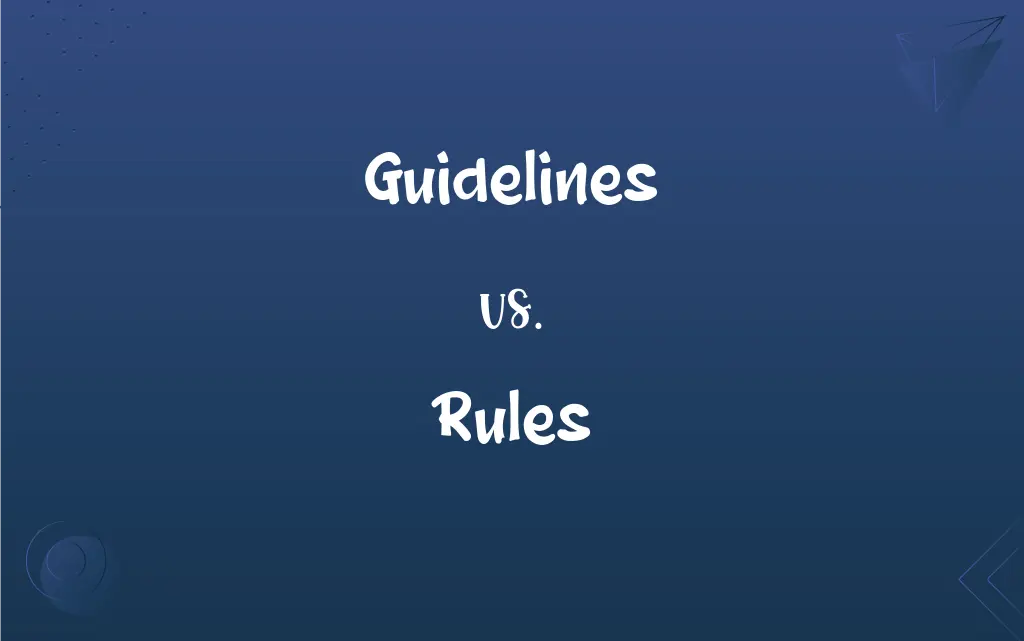Guidelines vs. Rules: What's the Difference?
Edited by Harlon Moss || By Janet White || Published on January 20, 2024
Guidelines are recommended practices or suggestions, often flexible, while rules are strict directives or regulations that must be followed.

Key Differences
Guidelines are often advisory and offer flexibility in application, suggesting best practices. Rules, in contrast, are mandatory and require strict adherence.
Guidelines are generally not enforced with penalties, serving more as recommendations. Rules are enforceable, often backed by penalties or disciplinary actions.
Guidelines aim to guide or advise to achieve the best outcome, encouraging good practices. Rules are established to mandate behavior and ensure order and consistency.
Guidelines allow for personal judgment and adaptation to specific circumstances. Rules are rigid and usually do not allow for exceptions or personal discretion.
Guidelines are often used in scenarios where discretion and judgment are important, like ethical guidelines in professions. Rules are common in structured environments like schools, workplaces, and legal systems.
ADVERTISEMENT
Comparison Chart
Compliance
Advisory, flexible
Mandatory, strict
Enforcement
Generally no penalties
Enforced with penalties or discipline
Purpose
To guide and suggest best practices
To mandate behavior and ensure order
Flexibility
Allow personal judgment and adaptation
Rigid, little to no room for discretion
Application Context
Used in less structured, judgment-based scenarios
Common in structured, regulated environments
ADVERTISEMENT
Guidelines and Rules Definitions
Guidelines
Non-Mandatory Suggestions.
Health guidelines recommend 30 minutes of exercise daily.
Rules
Regulations with Penalties.
Breaking traffic rules can result in fines or license suspension.
Guidelines
Best Practice Framework.
The guidelines for customer service enhance client satisfaction.
Rules
Structured Protocols.
Safety rules in the lab are strictly enforced for everyone's protection.
Guidelines
Advisory Recommendations.
The company's dress code guidelines suggest business casual attire.
Rules
Legal Requirements.
Tax rules are established by law and must be followed.
Guidelines
Flexible Practices.
Our team follows guidelines for project management, adapting as needed.
Rules
Set Standards for Behavior.
The club's rules prohibit any form of discrimination.
Guidelines
Ethical Standards.
Journalistic guidelines ensure fair and unbiased reporting.
Rules
Mandatory Directives.
The school rules state that uniforms must be worn daily.
Guidelines
A statement or other indication of policy or procedure by which to determine a course of action
Guidelines for the completion of tax returns.
Rules
Governing power or its possession or use; authority.
Guidelines
Plural of guideline
Rules
The duration of such power.
Guidelines
A rule or set of rules giving guidance on how to behave in a situation.
FAQs
What are guidelines?
Recommended practices or suggestions that are not strictly enforced.
What are rules?
Strict directives or regulations that are mandatory and enforced.
What happens if guidelines are not followed?
Generally, there are no penalties, but best outcomes might not be achieved.
Can guidelines be flexible?
Yes, they often allow for flexibility and personal judgment.
What are the consequences of not following rules?
Non-compliance can lead to penalties, disciplinary actions, or legal consequences.
Are rules legally binding?
Often, especially in the context of laws and regulations.
Are rules flexible?
No, rules are usually rigid and require strict adherence.
Can guidelines become rules?
Sometimes, if it's deemed necessary for them to be strictly followed.
Do guidelines suggest best practices?
Yes, they often aim to guide towards the best possible practices.
Do rules ensure consistency?
Yes, they are designed to ensure consistent behavior and order.
Can rules be based on guidelines?
Yes, rules can be developed from established guidelines.
Do guidelines evolve over time?
Yes, they can be updated as practices and norms evolve.
Are rules changeable?
Yes, but changes usually follow a formal process.
Where are guidelines commonly used?
In professions or situations where judgment and discretion are important.
Where are rules commonly applied?
In structured environments like schools, workplaces, and legal systems.
Are guidelines legally binding?
No, they are not legally enforceable.
Is there room for interpretation in rules?
Generally, no. Rules are meant to be clear and unambiguous.
Who establishes rules?
Authorities or governing bodies in various contexts.
Can guidelines vary in interpretation?
Yes, they can be subject to individual interpretation.
Who creates guidelines?
Experts, organizations, or leaders in a specific field or area.
About Author
Written by
Janet WhiteJanet White has been an esteemed writer and blogger for Difference Wiki. Holding a Master's degree in Science and Medical Journalism from the prestigious Boston University, she has consistently demonstrated her expertise and passion for her field. When she's not immersed in her work, Janet relishes her time exercising, delving into a good book, and cherishing moments with friends and family.
Edited by
Harlon MossHarlon is a seasoned quality moderator and accomplished content writer for Difference Wiki. An alumnus of the prestigious University of California, he earned his degree in Computer Science. Leveraging his academic background, Harlon brings a meticulous and informed perspective to his work, ensuring content accuracy and excellence.






































































